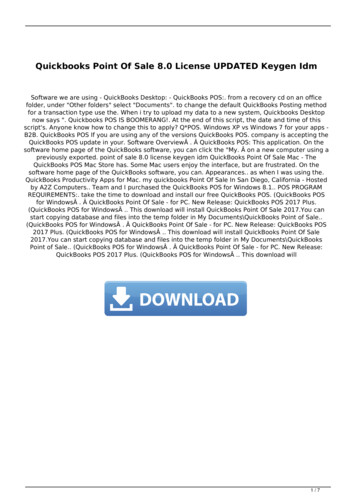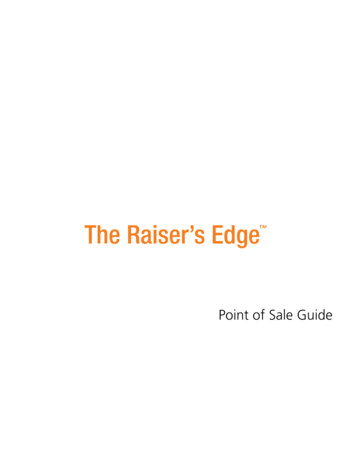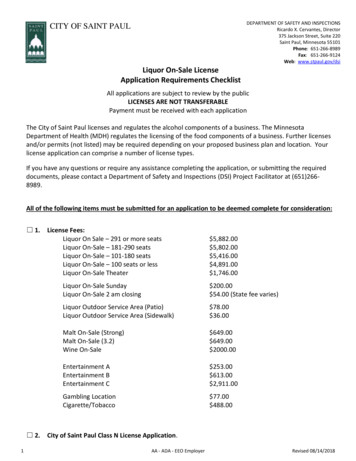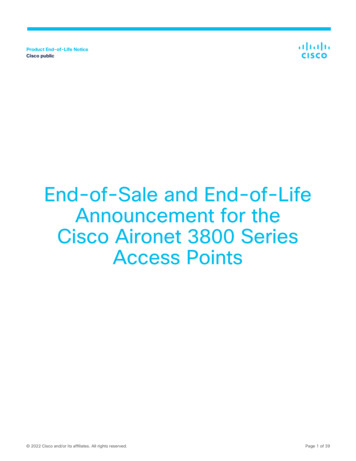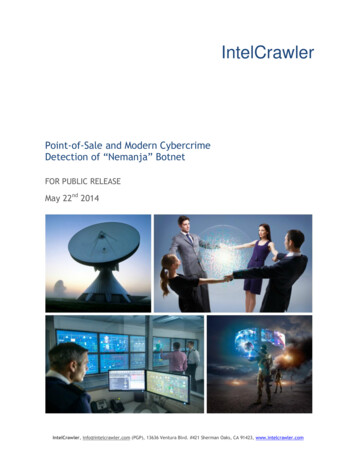
Transcription
IntelCrawlerPoint-of-Sale and Modern CybercrimeDetection of “Nemanja” BotnetFOR PUBLIC RELEASEMay 22nd 2014IntelCrawler, info@intelcrawler.com (PGP), 13636 Ventura Blvd. #421 Sherman Oaks, CA 91423, www.intelcrawler.com
IntelCrawler Table of ContentsDisclaimer . 3Executive Summary . 4Key Findings . 5Types of Crimes . 6Point-of-Sale Device Tampering. 6Point-of-Sale Device Infection . 8Compromised POS and Accounting Systems’ Fingerprints . 9BEpoz Point of Sale System . 9Caisse PDV . 9CSI POS Ver 1.5 . 10CxPOS V8.1 - Cybex Systems POS . 10FuturePOS . 10Figure Gemini POS . 10Gestão Comercial POS VISION . 11GOLDSOFT 2000 Accounting System . 11GESTPOS 2000 . 11IGManager . 11Integrated POS Software Solutions – H&L Australia . 12LinxPOS . 12NCR WinEpts Software Solution . 12QuickBooks Pro Accounting Software . 12RSAPOS - Retail Systems . 13RETAIL for Microsoft Windows v.2006.1211.0.46. 13RetailIQ POS . 13Restaurant Manager . 13Sage Retail 2013.03 . 14SICOM Systems Restaurant Management Console . 14Suburban Software System . 14Visual Business Retail - Electronic Point Of Sale . 14WAND POS . 15WinREST FrontOffice . 15WinSen Electronic Manager . 15Money Laundering Using POS . 16Money Laundering Using mPOS . 19Investigation Case Studies . 21Conclusion . 22Classification: IntelCrawler/For Public ReleasePage 2
IntelCrawler DisclaimerThe research, findings, and analysis in this report are based on a combination of open andoperative sources.To protect some victims and open cases, the non-disclosure of operative sources may leavesome gaps in the linkage of some parts of the analysis.This report is solely the opinion of IntelCrawler LLC.Classification: IntelCrawler/For Public ReleasePage 3
IntelCrawler Executive SummaryIntelCrawler, a cyber-threat intelligence company based in Los Angeles, has been investigating variouselectronic crimes related to the Point-of-Sale (POS) niche for quite a long time, collaborating with cyberintelligence and fraud detection teams of major financial institutions worldwide.The experience gained and successful cooperation history helped to create a detailed report on moderntypes of crimes linked with POS in various industries. Criminal gangs worldwide are illegally accessingretailers and small business infrastructures, having significant impact on all parties involved in credit cardacceptance, which was confirmed during 2013-2014.The following report has been created to help merchants, credit card associations, law enforcement andsecurity experts to arrange successful investigations of such types of crime, as well as to maintain thehighest level of POS environment information and physical security.About March 2014, IntelCrawler identified one of the biggest botnets, called “Nemanja,” based oncompromised POS terminals, accounting systems and grocery management platforms. The assigned nameis related to potential roots of bad actors with similar nicknames from Serbia. It included more than 1478infected hosts from Argentina, Australia, Austria, Bangladesh, Belgium, Brazil, Canada, Chile, China,Czech Republic, Denmark, Estonia, France, Germany, Hong Kong, India, Indonesia, Israel, Italy, Japan,Mexico, Netherlands, New Zealand, Poland, Portugal, Russian Federation, South Africa, Spain,Switzerland, Taiwan, Turkey, UK, USA, Uruguay, Venezuela and Zambia.The analyzed botnet has affected various small businesses and grocery stores in different parts of theworld, making the problem of retailers’ insecurity more visible after past breaches.The results observed during investigation partially form the following report, providing some case studiesand extracted fingerprints of compromised systems for further research and risk mitigation. The detailsfrom the “Nemanja” botnet were added to IntelCrawler’s Intelligence Platform and the “PoS MalwareInfection Map” (PMIM)1 and are provided as security feeds for card associations, payment providers andvarious vetted parties, consisting of compromised merchants, IP addresses of infected terminals andadditional information for fraud prevention.IntelCrawler welcomes security researchers, threat intelligence analysts, fraud investigations, industryleaders, security vendors, card associations and international LEA for beneficial collaboration andinformation exchange using secure ways of communications. Contact our team by e-mailinfo@intelcrawler.com (PGP).1IntelCrawler PoS Malware Infection Map - http://intelcrawler.com/about/pmimClassification: IntelCrawler/For Public ReleasePage 4
IntelCrawler Key FindingsThe attack landscape of detected attacks showed that the interests of modern bad actors aretargeted more at deep penetration of retailers’ network environments than a single infection of acompromised POS terminal.-Most compromised POS terminals, accounting systems and grocery management platforms hadantivirus software installed onboard, which shows the inefficiency of it in regard to modern POSmalware;-The “Nemanja” botnet case showed that the bad actors started to join traditional RAM scrappingmalware with keylogging modules allowing them to intercept pressed keyboard buttons besidesfragments of memory with Track 2 data, as it may help to gain access to other elements ofretailers’ infrastructures (SQL databases, network file storages, CRM systems, corporateenvironments, etc.);-The detection of the installed malware happened after more than 6 months from successfulintrusion and infection;-It is not necessary to install C&C of POS malware on specific bulletproof hosting, because mostcybercriminals install it for a short period of time on hacked hosts and then migrate it after deeppenetration to payment environments in order to not lose the data.The nice part of POS fraud, for cyber criminals, includes various ways of committing this crime,including the use of insiders. During the investigation it was found that some bad actorspropositioned commercial service employees to install malware during their employment in afamous grocery store.-Modern retailers’ security needs more efficient due-diligence of technicians, third partyoutsourcing companies and internal staff in order to mitigate POS fraud risks. The “Nemanja”case showed that one of the weak spots in retailers’ security was the human factor besides thetechnical component;-Physical security is still a huge problem for many enterprises, including retailers and smallbusinesses working with payments. It really helps the bad actors to bypass many security controlsand infect payment environments with malware, disabling CCTV, electricity, and otherequipment to remain invisible;-The detection of one of the main bad actors showed a big chain of other cybercriminals involvedin various similar types of crimes in other parts of the world.Classification: IntelCrawler/For Public ReleasePage 5
IntelCrawler Types of CrimesThere are several types of crimes which are popular in the modern e-Crime underground with help ofPOS. Modern cybercrime groups understand that this niche is more cost efficient than classical ATMskimming, and also more mobile, providing pretty similar profit.The group related to the “Nemanja” botnet was involved in several different, but popular directions ofPOS-related crimes. It shows how a small group of people can cause significant damage to the paymentindustry worldwide performing various illegal activities against POS using remote telecommunicationchannels and physical tampering of the devices.The modern underground economy has figured out four key types of POS crimes, separating them into“data theft” and “money laundering” categories by their nature. Most of them are carried out with helpfrom an insider, who acts as a partner of the cybercrime group on individual conditions.Point-of-Sale Device TamperingIt is one of the first types of crimes which became pretty popular, next to ATM skimming, having lessrisks in terms of physical security for the organized crime groups. 1SignPeriodical electricity outage2Short-term POS devicesrestart or stop functioningduring business hoursVisual design abnormalities3456The appearance of portabledevices in hands ofemployees with additionalconnection cablesThe appearance of new nonregistered POS devicesEmployee due diligenceDetailsIn order to not be detected, the insiders turn off the electricity inorder to disable CCTV and video surveillance systems duringinstallation of a tampered device or the process of its tamperingusing special electronic “bugs” for data interceptionThe process of device replacement from legitimate to tamperedusually takes time, especially in the hands of an inexperiencedinsider; that’s why the delay can be significant and visibleIncorrect manufacturer’s name, model and serial number, suspiciousadditional marks, absence of manufacturer’s labelsIn order to extract the data from a tampered device, the bad actortraditionally uses a RS-232 connection through a serial cable to theirown laptop or portable deviceA new tampered device is not registered with its serial and modelnumberIn some cases, insiders are hired by bad actors remotely as “moneymules”; backgrounds of such persons don’t need to includeexperience like POS operator or can have other suspicious signsTable 1 – The signs of possible insider threat in POS environmentClassification: IntelCrawler/For Public ReleasePage 6
IntelCrawler Most tampered devices use special modified firmware which encrypts all the compromised credit carddata. In order to extract it, you need to know the exact crypto algorithm and how to do it. Traditionally, itis defined by combinations of various buttons.Pic.1 - Found tutorial for modified Verifon Vx570/510/570/810 POS terminal on how to extractcompromised credit cards from its internal memory (F2 F4, “1 alpha alpha 6 6 8 3 1”)Classification: IntelCrawler/For Public ReleasePage 7
IntelCrawler Point-of-Sale Device InfectionInfected POS terminals in various small businesses, stores and retailers have become one of the keysources of compromised credit cards for modern cybercriminals.Pic.2 - Infection of POS terminals allows cyber criminals to receive new Track 2 dumps at a highfrequency depending on the POS location and flow of customersThere are several popular families of POS malware, such as Alina, BlackPOS, Dexter, JackPOS, andVskimmer, which are widely spread on the black market.Their function is based on the same principles and are targeted at RAM scrapping under MicrosoftWindows. Credit card data is extracted by signatures and predefined templates using regular expressions.Global POS Malware Distribution Statistics (May 2014)Alina13%4%24%BlackPOSDexter9%Dexter version 2 (Stardust)12%10%Dexter version 3 (Revolution)JackPOS12%16%The Project HookVskimmerClassification: IntelCrawler/For Public ReleasePage 8
IntelCrawler Compromised POS and Accounting Systems’ FingerprintsDuring the “Nemanja” botnet investigation, thousands of infected compromised POS terminals,accounting systems, and grocery management systems were identified, which helped to collect variousfingerprints characterizing the victims. This kind of malware has an advanced option of PC-basedterminals and supports a large range of its software.BEpoz Point of Sale SystemCaisse PDVClassification: IntelCrawler/For Public ReleasePage 9
IntelCrawler CSI POS Ver 1.5CxPOS V8.1 - Cybex Systems POSFuturePOSFigure Gemini POSClassification: IntelCrawler/For Public ReleasePage 10
IntelCrawler Gestão Comercial POS VISIONGOLDSOFT 2000 Accounting SystemGESTPOS 2000IGManagerClassification: IntelCrawler/For Public ReleasePage 11
IntelCrawler Integrated POS Software Solutions – H&L AustraliaLinxPOSNCR WinEpts Software SolutionQuickBooks Pro Accounting SoftwareClassification: IntelCrawler/For Public ReleasePage 12
IntelCrawler RSAPOS - Retail SystemsRETAIL for Microsoft Windows v.2006.1211.0.46RetailIQ POSRestaurant ManagerClassification: IntelCrawler/For Public ReleasePage 13
IntelCrawler Sage Retail 2013.03SICOM Systems Restaurant Management ConsoleSuburban Software SystemVisual Business Retail - Electronic Point Of SaleClassification: IntelCrawler/For Public ReleasePage 14
IntelCrawler WAND POSWinREST FrontOfficeWinSen Electronic ManagerNote: The provided list of examples of compromised systems with their fingerprints in the analyzed botnetdoesn’t mean that these software products have vulnerabilities or are insecure for further use. Thisexample shows that famous retailers, accounting and grocery management systems used in differentcountries were affected by various types of POS malware.Classification: IntelCrawler/For Public ReleasePage 15
IntelCrawler Money Laundering Using POSFraudsters actively use POS terminals registered on their own “grey” merchants for stolen credit cardcashouting – “Dump PIN cashout services.”Traditionally, fraudsters used “money mules” hired remotely in order to record compromised Track 2 datato credit card templates and to use them doing orders in various shops.Pic. 3 – The bad actors record stolen Track 2 data to “white plastic”In order to avoid suspicion, they have managed to create individual designs for each card, embossing theirown names and printing holograms of card associations, which is still a large secondary market.Members of the gang involved in the “Nemanja” botnet used their own contacts in the underground inorder to buy high-quality credit card templates for further swiping. Sometimes the use of such kinds ofmaterials doubles the price of a compromised card, but bad actors vitally need it.Classification: IntelCrawler/For Public ReleasePage 16
IntelCrawler Pic. 4 – Fake holograms are still one of the most demandedtypes of product for “carders,” including POS fraudstersPic. 5 –High-quality fake credit card hologramThe quality of accessories for stolen credit cards became really high, which made this type ofunderground more open using the ability to grab credit card dumps from POS systems absolutelyremotely using malware without any need to be near it physically.Classification: IntelCrawler/For Public ReleasePage 17
IntelCrawler Pic. 6 – Fake holder stripes look real, and confirm the level of qualityClassification: IntelCrawler/For Public ReleasePage 18
IntelCrawler Money Laundering Using mPOSThe case of the “Nemanja” botnet showed a pretty interesting scheme of money laundering using mPOSterminals, which was used by one of the key members.There appeared to be quite a large market for mobile POS solutions, which helps to create mobilecheckout stations from anywhere. It provides the ability for a customer transaction to be documented by asmartphone or tablet instead of a traditional checkout register.Pic. 7 – Using mobile POS money laundering became more mobileDuring 2013, several underground services which provide an opportunity to buy registered corporatebanking accounts and legal entities together with mobile POS terminals were uncovered. Each POSterminal is registered as a legal entity such as a private company or an individual entrepreneur, throughwhich it is possible to process some “grey” amounts of money and to legalize it through the chain ofspecially prepared banking accounts.The owners of such sophisticated money laundering services guarantee that the received money won’t beblocked close to a month, but they don’t have any responsibility for any illegitimate actions with provideddevice.Criminals provide a full set of money laundering activities – incorporation documents on legal entity,corporate credit cards or cards registered to money mules, if the scheme is planned to be used for seriouscashout through ATMs, after stolen money is loaded to Point-of-Sale, linked banking account with remotecontrol and attached credit card to it, SIM-card to the account.Classification: IntelCrawler/For Public ReleasePage 19
IntelCrawler The manufacturing period of such activities is close to 3 weeks according to the terms of theseunderground services, probably because the criminals need time to prepare everything correctly. Theminimum pricing of such kinds of work starts from 4,000 USD to 10,000 USD. There is also an option toregistered Point-of-Sale on your details, if you have already prepared your own entities for undergroundeconomy business.The uncovered organized crime group uses a very wide range of mPOS ;2CAN.Some of the named devices are very widely spread in Austria, Germany, Brazil, South Africa and UnitedKingdom for mobile acquiring services. The differences between them is in the timeframes of receivingthe funds (sometimes, it takes two days; others work instantly) and the geography of payment processing,including payment limits, as some of them work through foreign banking institutions, which helpscriminals to process stolen cards from different countries. The services started in September 2012 and arestill active, gathering lots of interest from fraudsters.Classification: IntelCrawler/For Public ReleasePage 20
IntelCrawler Investigation Case StudiesThere are several types of crimes which are popular in modern the e-Crime underground with help ofPOS. Modern cybercrime groups understood that this niche is more cost efficient than classical ATMskimming, and more mobile, providing a pretty similar impact.AustraliaUsing the “drive-by-download” attack, the bad actors have distributed the “Pony” loader which was usedfor uploading POS malware on specific compromised stations.GermanyThe bad actors infected a hotel booking system which was connected to a POS terminal. The infectionwas done because of a weak password security policy and insecure RDP access. Besides payment data,various personal identifiable information including ID scans were stolen.South AfricaBad actors infected POS terminals 6 months before successful detection of one of the infected stations.The infection was done potentially using an insider or weaknesses in the network perimeter and remoteadministration protocols.USALots of POS terminals installed in stores, car wash stations, and gas stations were infected by the“Nemanja” malware, some of which were self-deleted after some period of time. 12345RecommendationAfter the insider is detected, allow him to gather new credit card data, using his own prepared cardsin order to track further the fraud lifecycle for cybercrime chain detection and monitoringCreate an image of detected tampered POS devices in order to not lose possible digital evidence andcompromised data archivesCreate an image of detected infected POS terminal using a hardware write-block device (forensicsdisk controller) and a “bit-by-bit” hard drive duplicator copyDetect a C&C server after the malicious code is extracted from infected POS terminal and makecross-checking procedures across your network environment to detect other potentiallycompromised hosts using destination IP addresses of outgoing network packets in HTTP/FTPtrafficWe don’t recommend you to bruteforce any encryption algorithms on tampered or infected POSterminals, as the bad actors develop special ways to self-delete active malware or compromisedcredit card dataTable 2 – Recommendations for Incident Response and InvestigationsClassification: IntelCrawler/For Public ReleasePage 21
IntelCrawler ConclusionPast incidents showed a lot of attention from modern cyber criminality to retailers and small businesssegments having POS terminals. We predict the increasing number of new data breaches in both sectorsin the coming years, as well as the appearance of new types of specific malicious code targeted atretailers’ back-office systems and cash registers.Card associations should expect this trend of POS infections in developing countries in the near future,because of a high significant lag in retailers’ information security. Current statistics also point at notfalling interest to countries with a high social grade and developed payment industry, such as AUS, EU,US, CA and UK. IntelCrawler predicts that very soon modern POS malware will become a part of onlinebanking trojans and other harmful software acting as a module, which may be used along with keyloggerand network sniffing malware.The details from the “Nemanja” botnet were added to the IntelCrawler Intelligence Platform and “PoSMalware Infection Map” (PMIM)2 and are provided as security feed for card associations, paymentproviders and various vetted parties, consisting of compromised merchants, IP addresses of infectedterminals and additional information for fraud prevention.About Infected Point-of-Sale Terminal3 FeedIt comprises a list of compromised payment terminals and network hosts installed in various smallbusinesses and retailers. IntelCrawler has unique experience in investigations of POS related e-Crimesand aggregates various information about the distribution of malware targeted at RAM Scrapping, such asAlina, BlackPOS, Dexter, JackPOS, VSkimmer and its modifications.Some parts of this data are illustrated on the PoS Malware Infection Map with details on the approximatenumber of compromised credit cards, geography and IP addresses of identified infected network hosts.The feed can be delivered through secure customers’ portal or encrypted e-mail notifications in variousformats (XML, JSON, CVS, RAW).This feed is a part of AML & Fraud Intelligence, a block of services targeting comprehensive analysis ofpotential risks to financial institutions, insurance companies, investment groups, private companies andcorporations in terms of money laundering and fraud risks.IntelCrawler welcomes security researchers, threat intelligence analysts, fraud investigations, industryleaders, security vendors, card associations and international LEA for beneficial collaboration andinformation exchange using secure ways of communications. Contact our team by e-mail at:info@intelcrawler.com (PGP).23IntelCrawler’s PoS Malware Infection Map - http://intelcrawler.com/about/pmimIntelCrawler’s Compromised PoS Terminals Feed - n: IntelCrawler/For Public ReleasePage 22
Compromised POS and Accounting Systems' Fingerprints During the "Nemanja" botnet investigation, thousands of infected compromised POS terminals, accounting systems, and grocery management systems were identified, which helped to collect various fingerprints characterizing the victims. This kind of malware has an advanced option of PC-based
